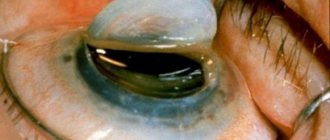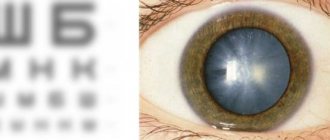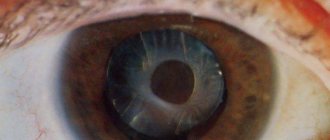The method of laser vision correction is constantly being improved. New techniques are emerging that level out the imperfections of other types of operations. Each of them has its own characteristics, advantages and disadvantages. Let's find out what they are and how the choice is made in favor of one method or another?
In this article
- Types of laser vision correction surgeries
- Photorefractive keratectomy
- Laser subepithelial keratomileusis
- Laser keratomileusis
- Super LASIK
- Femtosecond laser vision correction ReLEx SMILE
Laser vision correction today is considered one of the safest and most effective methods of treating visual pathologies. There are not many contraindications to the procedure, and complications are extremely rare. However, no one is safe from them, as with any operation. The very principle of laser treatment has become a major breakthrough in medicine. Millions of people, thanks to laser technology, have been able to regain their vision and give up glasses and contact lenses forever.
The method of laser vision correction is being modernized. New types of operations make it possible to cure many patients for whom laser procedures were contraindicated 10-15 years ago. Today, there are several basic methods for restoring visual functions using laser.
Types of laser vision correction surgeries
All laser techniques for eliminating refractive errors are similar. The essence of any operation is as follows: the doctor cuts off the surface layer of the cornea and corrects its shape with a laser beam. After this, the flap is returned to the area corrected by the laser, or it is completely removed, and a bandage lens is installed on the eye. The techniques differ in certain nuances, namely in how the corneal flap is separated. The entire treatment depends on such a seemingly small detail: from the prescription to possible complications.
So, the following laser methods of vision correction are used:
- photorefractive keratectomy (PRK);
- laser subepithelial keratomileusis (LASEK);
- laser keratomileusis (LASIK / LASIK);
- femtosecond laser vision correction ReLEx SMILE.
Let's take a closer look at each type.
Types of eye surgeries
There are many types of ophthalmic surgeries. For example, eye surgery eliminates many eye defects (myopia, lens opacity). Nowadays, patients are often offered surgical treatment with laser or ultrasound. with such severe eye pathology as retinal detachment or rupture. Surgical interventions on the lens, replacing it with an artificial one, are used in the progression of cataracts. Sometimes ophthalmologists are forced to remove the contents of the eyeball or cornea during purulent inflammation (panophthalmitis). On the vitreous body, intervention is indicated if it is damaged or if there is blood (hemophthalmos). In this case, vitrectomy is proposed - removal of the vitreous body. What types of eye surgical interventions are used in modern ophthalmology?
Let's take a closer look at the main methods of eye surgery.
Photorefractive keratectomy
PRK is the very first laser vision treatment technique. It was created in the 80s of the XX century and is still relevant. The latest methods have practically replaced PRK, but there are indications when doctors prescribe this particular operation: a very thin cornea and too wide pupils. During the procedure, the surgeon removes the surface layer of the cornea and performs laser ablation - evaporation of the corneal tissue with a laser pulse. This way it is given the correct shape, in which the light rays will form an image directly on the retina. A protective lens is then placed on the eye to promote rapid healing and prevent foreign objects from reaching the surface of the eye.
The procedure is performed under local anesthesia. It lasts approximately 10 minutes on one eye. The laser itself takes no more than two minutes to operate. The disadvantage of PRK is that after the operation the patient feels pain in the eye, dryness, and burning. The eyes become more sensitive to light. Going outside during the day without sunglasses will be dangerous for your eyes and quite painful. This is due to the restoration of the epithelial layer of the cornea, which was removed during the procedure. Epithelization of the operating surface will be completed in 3-5 days. During this period, the patient needs to instill special drops into the eyes, which the doctor will prescribe.
Vision does not return immediately after PRK surgery, but gradually. In the first days after the procedure, visual acuity will definitely not be maximum. Within a month it will recover by about 80%. A further increase in visual acuity will occur in the next two months. There are almost no complications after PRK if you follow all the recommendations of the ophthalmologist regarding sports, eye strain and hygiene. Hypothetical complications include:
- infectious ophthalmological diseases;
- halos and glare around luminous objects;
- temporary clouding of the cornea.
Advantages of outpatient surgery at MGK
- Before prescribing any treatment method, all patients undergo a thorough ophthalmological examination, including a full diagnosis using modern ophthalmological equipment and examination by an ophthalmologist under a microscope of the anterior segment of the eye and fundus (if indicated). This allows you to establish an accurate diagnosis and select the most effective treatment tactics.
- The Moscow Eye Clinic is a medical institution that brings together specialists from leading ophthalmological centers in Moscow. The Clinic employs doctors with scientific and practical experience, with tens of thousands of operations and cured patients behind them.
- The treatment of each patient guarantees effectiveness and minimization of complications. Comprehensive treatment is carried out; According to indications, medications (including various types of drug injections), laser or surgical treatment methods are used.
- Our clinic is equipped with modern medical equipment, allowing doctors to perform the most complex operations with high quality and precision.
- At all stages of treatment, adequate methods of pain relief and anesthesia are used, so the procedures are painless.
- Preference is given to outpatient treatment methods, as well as minimizing manipulation and surgery. If necessary, the patient is issued a certificate of incapacity for work.
- Our doctors take care of their patients, providing them with postoperative support until full recovery. The attentive attitude of all the Clinic staff guarantees good treatment results.
For any complaints related to the eyes, you should immediately contact a competent and professional ophthalmologist. Only timely consultation with a doctor will help you preserve your vision for a long time.
Laser subepithelial keratomileusis
LASEK is a modification of PRK. This operation has been used since 1999. It is a salvation for patients with dry eye syndrome, keratoconus and thinned cornea. Unlike PRK, LASEK does not remove the superficial layer of the cornea. He moves aside. In this case, this is done not with a scalpel or laser, but with the use of a 20 percent alcohol solution.
It is applied to the surface of the eye and softens the connections between the lower epithelial layer of the cornea and the upper one. After this, the upper part of the cornea is easily separated and removed to the side until the operation is completed. The next stage is standard. The laser eliminates the refractive error. Then the flap is placed in its original place, and a bandage lens is applied on top. Protective ophthalmic products with a high level of gas permeability will have to be worn for at least 4 days. During this time, the cornea will heal. The recovery process is less painful than after PRK. Normal vision will return to the patient in about a week.
Some side effects are possible after LASEK:
- sensation of a foreign body in the eye in the first two days;
- deterioration of twilight vision over several months;
- dry eyes for six months, which can be relieved with moisturizing drops;
- blurred vision that will go away in 6-9 months.
The patient should be observed by an ophthalmologist for about a year after laser correction.
Laser keratomileusis
LASIK is a more modern method of laser vision correction. The operation was first successfully performed back in 1987, but since then the technique has undergone many changes. Its modern modifications have appeared. The essence of any LASIK operation can be described in the following words: the surgeon forms a flap from the upper epithelial layer of the cornea, moves it back and corrects the shape of the cornea, completing the procedure by returning the flap to the operated area. The flap itself takes on the required curvature without sutures. A bandage lens is not applied after LASIK. The rehabilitation period lasts much less than after PRK and LASEK. Vision returns to the patient within a few hours after the operation. This method of laser correction is more gentle, since injury to the eye during the operation is minimal.
Today, LASIK is the most popular laser vision correction technique. In most cases, doctors prescribe this particular operation. There are different types of this technique called modifications of LASIK. There are 5 of them in total: Super LASIK, Femto-LASIK, Femto Super LASIK, Presby LASIK, Epi-LASIK.
Correction methods
There are several basic methods of laser vision correction. They differ in the type and model of the laser used, and the actual course of the operation.
The most famous types of laser microsurgery are:
- PRK
– photorefractive keratectomy. One of the first and already outdated methods based on the action of an excimer laser. The device corrects the configuration of the cornea by ablation of its surface layer. Since such an intervention is quite traumatic, it is used extremely rarely. Also, the risks of complications with this method of laser correction are quite high; clouding of the cornea may develop due to scarring processes. The recovery period for visual functions is also increased and is about 30 days. However, this method excludes exposure to the deep layers of the cornea and mechanical manipulation of the eye, which determines its advantages over other variations of laser correction. Also, in the postoperative period, the physical strength of the eye practically does not change, so there are no restrictions on activity after the intervention. - Lasik (LASIK)
. It differs from the previous one in the need to form a corneal flap. The manipulation is performed using a special device - a microkeratome, which provides access to the middle layers of the cornea tissue. The operation is performed simultaneously on both eyes, which saves time and effort in preparing for the intervention. The patient does not experience pain. - Super LASIK
. The technique of laser vision correction is deservedly popular due to the ability to take into account the individual characteristics of the structure of the cornea. A personalized approach is especially important in cases of complex refractive errors; it allows you to achieve better results with minimal trauma. The peculiarity of the Super LASIK method is the preoperative measurement of aberrations - distortions in the visual system. The aberrometer indicates all lower and higher order inaccuracies, which are subsequently corrected using laser technology. The result of the treatment is the ideal shape of the cornea, which provides the patient with normal refraction. The likelihood of complications is minimal. - FemtoLasik.
The technique differs in that a femtosecond laser is used to create a corneal flap. A non-contact method of influencing the surface layers of the cornea allows you to create thin sections and fully control the parameters of the corneal flap.
There are also modifications of laser vision correction such as Epi LASIK, LASEK and others. The choice depends on the characteristics of the clinical case and the financial capabilities of the patient.
Super LASIK
This is a laser correction method performed according to individual parameters. Almost the entire procedure is automated, so it allows you to achieve the most accurate results. Before surgery, a topographic examination of the patient's cornea is performed. In this way, an individual map of the state of the human visual organs is created. This map is loaded into the vision correction program. The steps of the operation are exactly the same as for LASIK.
Laser correction using the Super LASIK method allows you to achieve 100% visual acuity, which is a very high result, since 100% is not achieved even in people without visual pathologies. After Super LASIK, twilight vision improves. In the evening, a person will not be bothered by glare and halos, which is especially important for motorists. Super LASIK is prescribed to patients with very thin corneas. The minimal degree of laser damage to the eye during surgery virtually eliminates the risk of complications.
- Femto-LASIK
This is an operation performed using a femtosecond laser, a very precise laser that creates a thin corneal flap of a predetermined thickness. This ensures rapid healing of the eye after laser correction. The risk of complications is no more than 0.1%. According to medical statistics, only 1 eye out of 1000 has any complications. Of course, such an operation costs much more than the standard LASIK or PRK procedure.
- Femto Super LASIK
It is also prescribed to patients with a very thin cornea. This method of laser vision correction helps restore visual function to patients with severe myopia, when visual acuity is −25 diopters. During the operation, the doctor creates a corneal flap without any damage to nearby tissues. As a result, the recovery process becomes even shorter. The patient sees well within two hours after laser correction. Femto Super LASIK has, perhaps, only one drawback - its very high cost. But a person can forever get rid of the need to wear contact lenses and glasses. Ideal vision is maintained for many years.
- Epi-LASIK
Laser correction using the Epi-LASIK method is prescribed quite rarely. It is usually used to treat initial and moderate myopia, when the cornea has a flatter rather than elongated shape, as in late stage myopia. The flap is cut along the natural interface between the epithelial layers of the cornea. After the refractive error is corrected, a gas permeable contact lens is placed on the eyes. It prevents the flap from moving until it heals. The doctor will remove it in about three days. By this time the eye will have fully recovered.
Epi-LASIK is suitable for people whose professional activities involve high physical activity, for example, police officers, firefighters, athletes. The protective lens will prevent the corneal flap from moving, even if the eye is injured.
- Presby LASIK
Presby LASIK is used to treat presbyopia, an eye condition affecting people over 40 years of age. The patient has difficulty seeing small objects at a distance close to the eyes. If presbyopia develops as a result of myopia, a person needs two pairs of glasses. During laser correction, the doctor gives the cornea the same shape as multifocal lenses, which ensures full vision at near and far distances.
Femtosecond laser vision correction ReLEx SMILE
ReLEx SMILE is a new generation laser vision correction technique. The surgeon forms a kind of lens - a lenticule - directly in the inner layers of the cornea, which is removed through a micro-incision 2-4 mm long. In this way, the doctor gives the cornea the desired shape without resorting to creating a flap and removing it. Thanks to this, the ReLEx SMILE method can be performed even with dry eye syndrome, and this disease is a contraindication for most laser surgeries. Another difference between ReLEx SMILE and PRK and LASIK is a shorter rehabilitation period. It is clear that the patient will have to pay much more for such a service.
In general, all types of operations are absolutely safe and provide high guarantees. The choice of procedure depends on the condition of the patient’s visual organs and his financial capabilities.
In what cases is laser treatment contraindicated?
Despite the advantages of laser treatment, this method cannot be used in all cases. Depending on the type of operation the patient needs, there are special contraindications. There are also conditions in which any laser intervention is prohibited. They are called general contraindications. These include: blood diseases - thrombophilia, the presence of severe pathologies of internal organs (decompensated heart failure, renal failure), degenerative processes of the spine and blood vessels. There are special contraindications for vision correction. These include: childhood, pregnancy and lactation. Also, surgery cannot be performed if a decrease in visual acuity is observed for less than 1 year.
As for varicose veins, this method is not used in patients who are unable to walk and wear elastic stockings immediately after the intervention (paralysis, obesity). If the saphenous vein is dilated by more than 1 cm, severe tortuosity of the vessels and the presence of a focus of inflammation, laser is also contraindicated. After the operation, the patient must lead an active lifestyle in the first days, but in the presence of the listed conditions this is impossible. Endoscopic interventions are not performed in case of an unspecified diagnosis and a large affected area.











